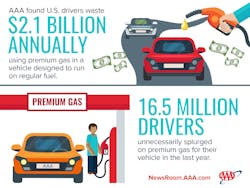Drivers waste $2.1 billion on premium gasoline, according to AAA research
American drivers wasted more than $2.1 billion dollars in the last year by using premium-grade gasoline in vehicles designed to run on regular fuel, according to new AAA research.
Currently fewer than 20 percent of vehicles on the road require high octane fuel, while 70 percent are designed to operate on regular gasoline. A national survey of motorists revealed that 16.5 million U.S. drivers used premium gasoline in a vehicle designed to run on regular fuel at least once in the past year.
“Many drivers think they are giving their car a treat by occasionally filling up with premium-grade gasoline, even though their vehicle calls for regular unleaded,” said Nick Jarmusz, Wisconsin director of public affairs for AAA – The Auto Club Group. “The consensus has been that higher octane does not mean higher quality, but AAA did a formal study to test that theory.”
Testing “Regular” vs. “Premium”
In partnership with the Automobile Club of Southern California’s Automotive Research Center, AAA tested 87-octane (regular) and 93-octane (premium) gasoline in vehicles equipped with a V-8, V-6 or I4 engine designed to operate on regular-grade fuel. To evaluate the effects of using a higher-octane fuel when it’s not required by the manufacturer, each vehicle was tested on a dynamometer, which is essentially a treadmill for cars.
The laboratory checked for improvements in vehicle:
- Horsepower
- Fuel economy
- Tailpipe emissions
Results
For vehicles designed to run on regular-grade fuel, using premium gasoline did not produce more horsepower, result in better fuel economy or produce fewer tailpipe emissions. Premium gasoline is specifically formulated to be compatible with specific types of engine designs and most vehicles cannot take advantage of the higher octane rating.
“AAA cautions drivers that premium gasoline is higher octane, not higher quality, and urges drivers to follow the owner’s manual recommendations for their vehicle’s fuel,” Jarmusz said. “Drivers looking to upgrade to a higher quality fuel for their vehicle should save their money and select a TOP TIER gasoline, not a higher-octane one.”
Quick Stats
Gasoline Grades
- Seventy percent of U.S. drivers currently own a vehicle that requires regular gasoline
- Sixteen percent drive vehicles that require premium fuel
- Fourteen percent own a vehicle that requires mid-grade gasoline (10 percent) or uses an alternative energy source (4 percent)
A national survey of motorists’ habits from the last 12 months:
- 16.5 million U.S. drivers used premium gasoline in a vehicle designed to run on regular fuel at least once
- U.S. drivers unnecessarily used premium gasoline in their vehicle more than 270 million times
- On average, those that upgraded to premium gasoline did so at least once per month
Finding Quality Fuel
Previous AAA research found that fuel quality varies significantly among gasoline retailers and that using a gasoline that meets TOP TIER standards can result in 19 times fewer engine deposits, increase vehicle performance and improve fuel economy. To protect vehicle investments, AAA urges drivers to use the appropriate gasoline as determined by their car’s manufacturer (regular or premium) that meets TOP TIER standards for engine cleanliness and performance. The following brands sell gasoline that has the TOP TIER certification, among others: Chevron, CITGO, Costco Gasoline, Exxon, Kwik Trip, Mobil, QuikTrip, Shell, Sinclair, Texaco.
Doing the Math
To calculate the total annual cost of using premium gasoline when not required by the vehicle manufacturer, AAA conducted a comprehensive analysis that included a U.S. consumer survey, Federal Highway Administration data, per-gallon costs of premium gasoline and regular gasoline and the average number of fill-ups annually. All testing was conducted at the Automotive Club of Southern California’s Automotive Research Center in Los Angeles, California, using an industry-standard chassis dynamometer, emissions test equipment and Environmental Protection Agency driving cycles. All gasoline used for testing was EPA Tier III certification fuel with ten percent ethanol content in both regular and premium grades. Certified test fuel was used to remove variability in fuel quality and additives. For this study, AAA did not evaluate the effects of using regular fuel in an engine that requires premium gasoline.
